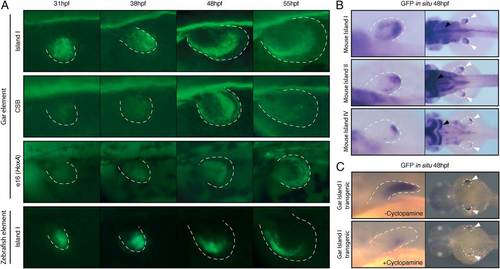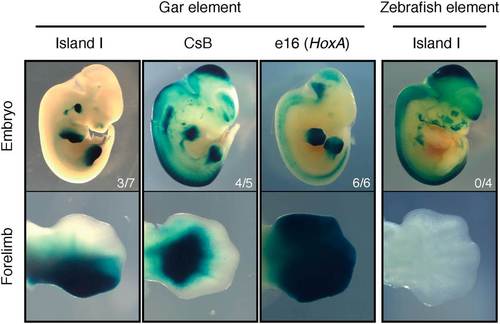- Title
-
Deep conservation of wrist and digit enhancers in fish
- Authors
- Gehrke, A.R., Schneider, I., de la Calle-Mustienes, E., Tena, J.J., Gomez-Marin, C., Chandran, M., Nakamura, T., Braasch, I., Postlethwait, J.H., Gómez-Skarmeta, J.L., Shubin, N.H.
- Source
- Full text @ Proc. Natl. Acad. Sci. USA
|
Transgenic zebrafish reveal the expression dynamics of multiple “autopod” regulatory elements present in fish genomes. (A) Left pectoral fins of stable zebrafish lines transgenic for putative late phase enhancers identified in Fig. 1 and Fig. S1. The gar Island I, CsB, and e16 enhancers all drove reporter expression at 48 hpf in a strip of expression at the distal edge of the fin. Island I from zebrafish, which was identified through ATAC-seq and 4C-seq, drove a pattern of expression nearly identical to its ortholog in gar. All views are dorsal, with anterior to the left, posterior to the right, except for e16 which shows a lateral view. (B) The expression patterns of mouse autopod enhancers Island I, Island II, and Island IV in transgenic zebrafish. (Left) Dorsal views of right pectoral fins; (Right) dorsal views of the embryo. Island I from mouse drove a pattern of expression that was strongest at 48 hpf, with most expression at the distal compartment of the pectoral fin. Similarly, mouse Islands II and IV were active distally in the pectoral fin. Expression in the brain (black arrows) is due to a strong hindbrain enhancer present in the vector that serves as a positive control for transgenesis. (C) Like their murine counterparts, fish late phase enhancers depend on Shh signaling. (Upper) Lateral view of an in situ hybridization for the GFP transgene at 48 hpf on an embryo transgenic for the gar Island I enhancer. (Lower) Reduced GFP expression in a transgenic embryo that was treated with the Shh inhibitor cyclopamine from 31 to 48 hpf. Distal edge of the fin is marked by a dotted white line in all pictures. |
|
Late phase enhancers from the nonteleost gar drive expression throughout the autopod in transgenic mice. Island I from gar drove expression in a posterior strip throughout the autopod and to the distal tip of the developing digits. Gar CsB drove strong expression in the autopod and in the presumptive digits. The hoxA late phase enhancer e16 from gar drove robust expression in the entire autopod, with a sharp boundary at the zeugopod. In accordance with previous reports, Island I from the teleost zebrafish had no activity in the autopod of transgenic mice. |


